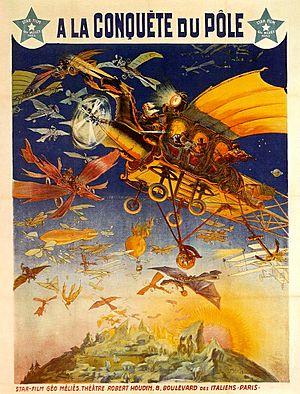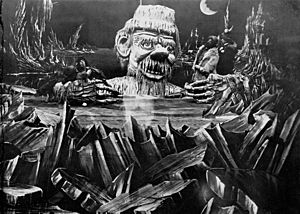The Conquest of the Pole facts for kids
Quick facts for kids The Conquest of the Pole |
|
|---|---|

Poster for The Conquest of the Pole
|
|
| Directed by | Georges Méliès |
| Produced by | Charles Pathé |
| Written by | Georges Méliès |
| Starring | Georges Méliès |
| Studio | Star Film Company |
| Distributed by | Pathé Frères |
| Release date(s) | 3 May 1912 |
| Running time |
|
| Country | France |
| Language | Silent |
The Conquest of the Pole (French: À la conquête du pôle) is a silent fantasy film from France made in 1912. It was directed by and starred Georges Méliès, a famous early filmmaker. The movie is loosely based on real events happening at the time and on the adventure books by Jules Verne.
The story follows a funny group of international explorers. They go on an exciting trip to the North Pole. On their journey, they meet a giant who eats people and a dangerous magnetic needle. This film was one of Méliès's last movies. It was well-liked in France and the UK, but it didn't make much money. Even so, it is still seen as one of his best works.
Story of the Film
The film begins at a big meeting of explorers. They are all at an Aero Club, which is a place for people interested in flying. Explorers from all over the world are arguing about the best way to fly to the North Pole. They can't agree on anything!
Then, the president of the meeting, a French engineer named Maboul, shares his idea. He wants to build an "Aero-Bus." This is a special airplane with a passenger area and a huge bird-shaped front.
Suddenly, a group of strong-willed women called suffragettes burst in. Suffragettes were women who fought for the right to vote. They announce that they plan to go to the Pole themselves! After they are chased away, the meeting chooses a team to go with Maboul. This team includes experts from England, America, Germany, Spain, China, and Japan.
Maboul takes his new team to his office. They study a small model of his amazing invention. Then, they visit the factory where the real Aero-Bus is being built using electricity. Meanwhile, the leader of the suffragettes tries her own plan. She builds a machine with propellers and many toy balloons. But it doesn't even get off the ground!
The finished Aero-Bus finally takes off, and everyone cheers. But there are two small problems. First, the suffragette leader tries to jump onto the plane at the last minute. Second, the explorer from China, Tching-Tchun, arrives late and is accidentally left behind!
Many other adventurers also try to reach the Pole in their own flying machines. Soon, the sky is full of all kinds of aircraft. Both Tching-Tchun and the suffragette leader try to reach the Pole in a balloon. But they both fail again. Tching-Tchun falls a short way and gives up. The suffragette holds on longer but falls onto a church steeple and disappears in a puff!
Meanwhile, the Aero-Bus flies smoothly through the sky. It passes by different planets and stars.
The aircraft then glides down over the Arctic ice. It finally crash-lands, but the explorers are all safe. Almost immediately, they face a huge problem: the Giant of the Snows! This giant is a huge, pipe-smoking monster who tries to eat people. The explorers have to scare him away with cannon fire.
Finally, they reach the North Pole itself. There, they find a giant magnetic needle. They get stuck to the needle because of its strong magnetic pull. The needle breaks under their weight, and they fall into the freezing water! They signal for help, and a passing airship rescues them. Penguins, seals, and Arctic birds wave goodbye as they leave. The explorers return to the Aero Club as heroes. They bow to everyone who has gathered to welcome them.
What Inspired the Film
Even though this film is a fantasy, many parts of its story came from real events. In 1909, Robert E. Peary and his team reached the North Pole. Then, in 1911, Roald Amundsen made it to the South Pole. Méliès started filming this movie just four months after Amundsen's trip. Another explorer, Frederick Cook, also claimed to have reached the North Pole before Peary. These real-life adventures gave Méliès many ideas.
Méliès once said about the film: "Both Cook and Peary said they reached the Pole. I don't think either one did. I said to myself, I'm going to go there."
The suffragettes in the film were also inspired by real life. The women's suffrage movement was very active at the time. These women were fighting for the right to vote. The suffragette leader in the film was even a funny version of a famous British campaigner, Emmeline Pankhurst. Even the scene where a suffragette tries to join the flying race was based on real news. Women like Thérèse Peltier and Raymonde de Laroche were making headlines as early female pilots in France.
Many people at the time thought the film was based on Jules Verne's books. However, it's not a direct copy of any of his famous Voyages Extraordinaires novels. Instead, it's a funny, playful tribute to the whole series. It's a bit like how Albert Robida made fun of Verne's stories in his own comic novel. The film might have been very loosely inspired by Verne's The Adventures of Captain Hatteras or The Sphinx of the Ice Fields.
Other ideas for the film came from plays and other movies. A big play called Pif Paf Pouf in 1906 had a Giant of the Pole moved by wires. It also had a powerful magnet at the Pole. Méliès borrowed both these ideas for his film. Another film from 1903, Voyage of the Arctic, also showed a giant at the Pole. This likely gave Méliès ideas too. Méliès might also have remembered that the Lumière Brothers filmed a fake Polar exploration in 1897.
How the Film Was Made
Georges Méliès is known as one of the first people to see how amazing movies could be for telling stories. His films like A Trip to the Moon (1902) and The Impossible Voyage (1904) were very popular. But by the time he made The Conquest of the Pole, his success was fading.
In 1911, Méliès made a deal with the Pathé Frères company. Pathé became the only company that could distribute his films. Even though Méliès still made the films at his Star Film Company studio in Paris, Charles Pathé had control over them. He could even change how long they were. So, all of Méliès's films from 1911 onwards, including The Conquest of the Pole, were made under Pathé's watch.
The Conquest of the Pole is Méliès's longest movie. It was 650 meters of film, which is about 44 minutes long. It was also the last of his "journey" films. This type of film included some of his most famous works, like A Trip to the Moon. Méliès made this film in the winter of 1911–1912. He even played the main character, Professor Maboul, himself! He also appeared briefly in another role, as one of the workers holding the balloon. Fernande Albany, who had been in many of Méliès's other films, played the leader of the suffragettes.
During his career, Méliès built two film studios made of glass and metal. The second one, Studio B, was much bigger. It had a stage about thirty feet wide. It also had a special elevator crane to move large objects. The Conquest of the Pole used Studio B's big space, especially for the scene with the Giant of the Snows. However, some scenes, like the parade of vehicles, were filmed outside.
Méliès used many cool tricks to create the film's special effects. He used stage machinery, pyrotechnics (fireworks), and scenery that moved up, down, and sideways. He also used miniature models, real water, and clever editing tricks. The Giant of the Snows was a huge marionette (a puppet moved by strings). It needed twelve men to operate it! Its head alone was two meters high. Two of the puppeteers even hid inside the head to control the Giant's eyes, ears, mouth, and pipe.
Most of the film is shot with a camera that stays still. This makes it look like you are watching a play on a stage. However, the scene where the airplane lands in the Arctic is special. The camera's view actually moves! First, the plane flies directly towards the camera. Then, in the next shot, the plane keeps moving, but the camera's view has turned. This was a new and advanced way of filming at the time.
See also
 In Spanish: À la conquête du Pôle para niños
In Spanish: À la conquête du Pôle para niños




